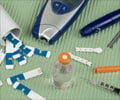AI model using voice analysis accurately identified undiagnosed type 2 diabetes and showed potential for non-invasive diabetes screening.

New AI technology uses voice analysis to detect undiagnosed type 2 diabetes
Go to source). A new study that will be presented at the European Association for the Study of Diabetes (EASD) Annual Meeting in Madrid, Spain, September 9–13, shows how speech analysis can be used to identify type 2 diabetes (T2D) cases that have not yet been identified.
The model was trained using an average of 25 seconds of people's voices and basic health data, such as age, sex, body mass index (BMI), and status of hypertension.
‘Did You Know?
Around 240 million adults worldwide are unaware that they have type 2 diabetes (T2D) #diabetes. #AI #healthtec #medindia’





Around 240 million adults worldwide are unaware that they have type 2 diabetes (T2D) #diabetes. #AI #healthtec #medindia’
Advertisement
Using Voice Analysis to Detect Type 2 Diabetes
Around half of adults with diabetes (around 240 million worldwide) are unaware that they have the condition because the symptoms can be general or non-existent—around 90% of these have T2D. But early detection and treatment can help prevent serious complications. Reducing undiagnosed T2D cases worldwide is an urgent public health challenge.The study set out to develop and assess the performance of a voice-based AI algorithm to detect whether adults have T2D.
Researchers asked 607 adults from the Colive Voice study (diagnosed with and without T2D) to provide a voice recording of themselves reading a few sentences of a provided, directly from their smartphone or laptop.
Both females and males with T2D were older (average age females 49.5 vs 40.0 years and males 47.6 vs 41.6 years) and were more likely to be living with obesity (average BMI females 35.8 vs 28.0 kg/m² and males 32.8 vs 26.6 kg/m²) than those without T2D.
From a total of 607 recordings, the AI algorithm analyzed various vocal features, such as changes in pitches, intensity, and tone, to identify differences between individuals with and without diabetes.
Advertisement
Comparing AI Models to ADA Risk Assessment
This was done using two advanced techniques: one that captured up to 6,000 detailed vocal characteristics, and a more sophisticated deep-learning approach that focused on a refined set of 1,024 key features.The performance of the best models was grouped by several diabetes risk factors including age, BMI, and hypertension, and compared to the reliable American Diabetes Association (ADA) tool for T2D risk assessment.
Advertisement
Results and Future Research Directions
The voice-based algorithms showed good overall predictive capacity, correctly identifying 71% of male and 66% of female T2D cases. The model performed even better in females aged 60 years or older and in individuals with hypertension.Additionally, there was 93% agreement with the questionnaire-based ADA risk score, demonstrating equivalent performances between voice analysis and a widely accepted screening tool.
“While our findings are promising, further research and validation are necessary before the approach has the potential to become a first-line diabetes screening strategy and help reduce the number of people with undiagnosed type 2 diabetes. Our next steps are to specifically target early-stage type 2 diabetes cases and pre-diabetes,” said co-author Dr Guy Fagherazzi from the Luxembourg Institute of Health, Luxembourg.
Reference:
- New AI technology uses voice analysis to detect undiagnosed type 2 diabetes - (https:www.news-medical.net/news/20240909/New-AI-technology-uses-voice-analysis-to-detect-undiagnosed-type-2-diabetes.aspx#:~:text=The%20study%20used%20on%20average,and%2071%25%20accuracy%20in%20men.)
Source-Eurekalert















